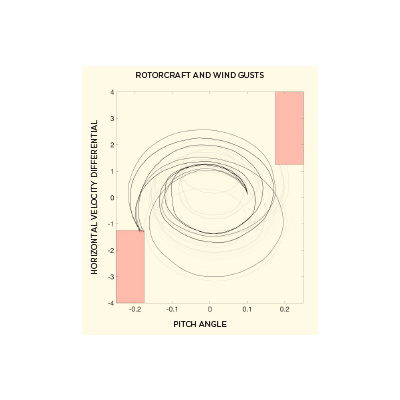Stay Up to Date
Submit your email address to receive the latest industry and Aerospace America news.
The Non-Deterministic Approaches Technical Committee advances the art, science and cross-cutting technologies required to advance aerospace systems with non-deterministic approaches.
The aerospace community faces a demand for better approaches to evaluate the non-deterministic and complex behavior of highly integrated aerospace systems reflecting real-world uncertainties. Two organizations that stepped up this year to meet that need were DARPA, which is funding the development of scalable uncertainty quantification methods for design of defense-related systems, and NASA, which is sponsoring a research team to understand how to fuse uncertain information sources into an air traffic management system.
Teams sponsored by DARPA’s Enabling the Quantification of Uncertainty in Physical Systems program made significant progress in 2017 in demonstrating scalable uncertainty quantification methods for system design. Several teams demonstrated scalability for aerospace problems, including SEQUOIA, or Scalable Environment for Quantification of Uncertainty and Optimization in Industrial Applications, which studied embedded engine nozzles; QUANTUM, a nickname for Inference, Simulation and Optimization of Complex Systems Under Uncertainty, which focused on turbulent jets; and SIRE, or Scalable Inference for Rare Events, which researched rotorcraft. The DARPA program aims to improve understanding of how uncertainties impact complex physical systems and to exploit this understanding to improve design. The DARPA-funded teams are tackling fundamental mathematical barriers to permit large numbers of uncertain input parameters and to account for uncertainties inherent in the large, nonlinear models used in realistic, multiphysics engineering problems.
In June, SEQUOIA discovered new engine nozzle shapes that robustly boosted thrust performance without adding significant weight. The SEQUOIA team is designing lightweight engine nozzles subjected to aerodynamic, thermal and structural uncertainty using model reduction, embedded model-form discrepancies and multilevel, multifidelity techniques for propagation, inference and design. That team includes Stanford University, Sandia National Laboratories, the University of Michigan and the Colorado School of Mines.
The researchers on team QUANTUM in August demonstrated a new way to solve an optimization under uncertainty problem for a turbulent jet with 1 million uncertain parameters by developing scalable, multifidelity uncertainty quantification methods to compute failure probabilities. They optimized horizontal velocity profile at the jet inlet boundary to maximize expected downstream jet width, while accounting for turbulence model uncertainties, and developed a control strategy to maintain performance and mitigate negative consequences of modeling inadequacies. The QUANTUM team includes the University of Texas at Austin, Caltech, Rice University and MIT.
The SIRE team of DARPA-funded researchers in August discovered rare rotorcraft pitch failures through a new dynamic, importance-sampling approach based on transport maps. The SIRE team includes researchers from the United Technologies Research Center and MIT. By investigating the non-deterministic response of a rotorcraft subject to uncertain gusts modeled as Ornstein-Uhlenbeck processes, the SIRE team aims to predict impending rotorcraft failure using streaming data in an online Bayesian setting.
NASA in June began sponsoring a five-year research center, led by Arizona State University, to study the safe integration of uncertain data sources in a dynamic, air traffic management system with the aim of influencing the FAA’s NextGen Air Transportation System. The research team, funded by NASA’s Aeronautics University Leadership Initiative, includes Vanderbilt University, Southwest Research Institute and Optimal Synthesis Inc. The center will investigate the dynamic and uncertain nature of human-cyber-physical interactions in air traffic management, which has not been previously explored from a system modeling perspective.
Researchers also extended the ability of non-deterministic approaches to unite multiple information sources. This exploration sought to reduce high computational costs by leveraging cheaper information sources. In research reported by the University of Dayton in July, locally optimized surrogate models were constructed and applied to aircraft design spaces. Research at Wright State University recast the Kriging method in a non-deterministic and non-stationary framework to manage uncertainties in models with different fidelities. In July, Wright State and Air Force researchers applied this framework to improve the effectiveness-based design of an aircraft under mission uncertainty.
Editor’s note: Regarding the graphic accompanying this article, researchers working under DARPA’s Scaleable Inference for Rare Events, or SIRE, project are learning to predict when wind gusts will pose a danger to rotorcraft by studying uncertain rotocraft responses to winds. The pink regions depict danger zones.
Contributors: Karen Willcox, Harok Bae, Corey Fischer, Yongming Liu, and Markus Rumpfkeil
Related Posts
Stay Up to Date
Submit your email address to receive the latest industry and Aerospace America news.




